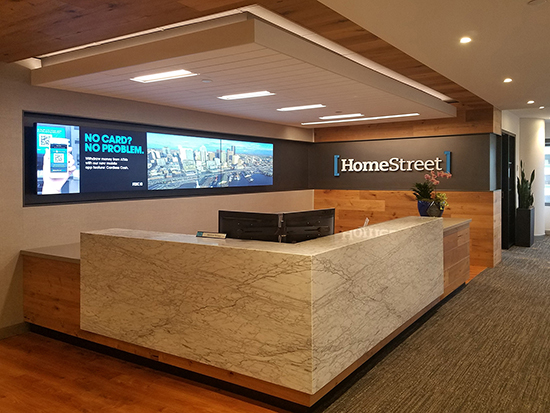|
Subscribe / Renew |
|
|
Contact Us |
|
| ► Subscribe to our Free Weekly Newsletter | |
| home | Welcome, sign in or click here to subscribe. | login |
Construction
| |
 |
May 11, 2018
Eagle of Excellence
Tenant Improvement/Renovation
$4 million-$10 million

HomeStreet Bank
corporate offices
Rafn Co.
Architect: MG2
Owner: HomeStreet Bank
Rafn proved itself again this year through its attention to four pillars — excellence, design, integrity and safety — and won the Eagle of Excellence Award for its HomeStreet Bank tenant improvement.
Rafn overcame limiting and often cumbersome conditions at Two Union Square in downtown Seattle, including coordinating with the building’s contractor and clients, which were in close proximity. This multi-phase tenant improvement spanned 26 months and covered 87,850 square feet.
Rafn installed a custom marble countertop on the reception desk, and reconfigured private offices, open offices, bathrooms, and conference and break rooms.
One of Rafn’s challenges was working with limited access to the site, in Seattle’s third largest skyscraper. With construction spanning over 12 floors, along with limited elevator and building access, Rafn had to plan ahead — often three to four weeks — in order to move materials and tradespeople in and out.
The size and weight of the materials that needed to be moved in and out of relatively small elevators posed another challenge.
Timing was also a limiting factor, requiring flexible schedules often well into the night and early hours of morning. The building has a strict policy requiring that construction materials not enter or leave the building between 7 a.m. and 6 p.m. This, paired with limited elevator access, meant that tradespeople often had to wait 15—20 minutes every day just to reach their particular job.
Restrictions on the permeation and presence of noise, dust and smells also required much of the work to be done after 6 p.m. to avoid disturbing tenants.
Hidden conditions such as crowded ceiling spaces made routing and installing new systems challenging due to the fact that crews had to fix previous work and find ways to install lighting components that wouldn’t interfere with sprinkler systems. During this process they also found the need to retrofit outdated sprinkler connections, which were not up to code.
The building’s ceilings and floors were not level or flat, requiring custom installation of each wall panel while working with special building requirements that didn’t permit alterations to the existing ceiling grid.
Of the 15,267 labor hours recorded on this project, there were zero OSHA-recordable injuries that required days away from work, nor were there any cases requiring job transfer or restriction.
Other Stories:
- The coming workforce challenge: filling 1M jobs
- Specialty Construction Commercial
less than $5 million - Merit Award Industrial
$5 million-$15 million - Merit Awards Infrastructure
up to $100 million - Merit Award Institutional
less than $5 million - Merit Award Tenant Improvement/Renovation
less than $4 million - Merit Award Tenant Improvement/Renovation
$4 million-$10 million - Survey: Lease Crutcher Lewis
- Survey: Skanska USA
- Survey: Schuchart
- Survey: The Walsh Group
- Survey: Synergy Construction
- Mechanical/Industrial
less than $5 million - Multifamily Construction
$25 million-$100 million - Seattle braces for metal tariff fallout
- Here’s how a modular hotel stacks up in Seattle
- We’ve got green buildings, how about green communities?
- Design-build done right: tips for success
- Tight site, deep hole? Bring on the teledipper
- Equipment sector’s heavy lift: regulations, employees
- Pyramid Award
Other Construction
$10 million-$25 million - Commercial Construction
$10 million-$25 million - Commercial Construction
$5 million-$10 million - Commercial Construction
less than $5 million - Healthcare less than $10 million
- Survey: Absher Construction Co.


